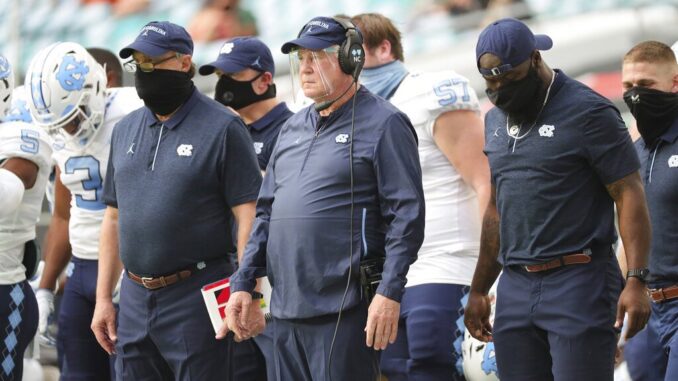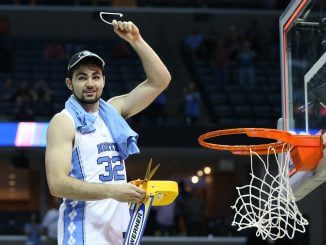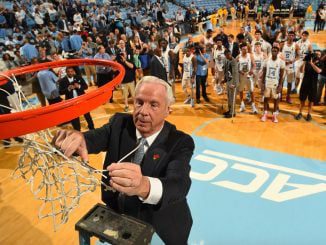
Coming off a trip to the Orange Bowl, North Carolina football is ready to take another step forward.
“We had a good year last year,” coach Mack Brown said. “We’re trying to be great.”
With junior quarterback Sam Howell and many returning stars on both sides of the ball, the Tar Heels have visions of competing for a berth in the College Football Playoff.
The number of berths available may be about to change.
“There’s been a proposal to have a 12-team playoff,” Brown said. “We took it to the players and asked what they thought since it’s going to affect them more than anybody else.”
Surprisingly, since the Tar Heels fully expect to be fighting for a berth, the players didn’t think more was better.
“Our players were against the 12-team playoff,” Brown said. “They were about evenly split between a six- and an eight-team playoff.”
The players were concerned about the length of the season, which could stretch to 17 games in a 12-team scenario. “They also weren’t sure there would be 12 teams good enough to win a national championship,” Brown said.
A potential change to the size of the playoff is just one of several major changes that Carolina, and the rest of college football, is navigating in this most uncertain of offseasons.
The staff has been busy trying to keep up with recruiting after the doors were opened for visits following a shutdown of more than a year due to the pandemic.
“Recruiting has been crazy in June,” Brown said. “We took 15 months of recruiting and put it in three weeks. So, as you can imagine, we had unofficial visits, we had official visits. We had evaluations, which we’ve never had before, where a young man could come in and we could work him out for an hour. We’ve never been able to do that before.”
Meeting the players in person has led to some surprises.
“All of a sudden, you go from 15 months of Zooming to seeing them, saying hello to them, sitting down to visit and actually recruiting them,” he said. “It’s amazing, sometimes you’d say, ‘Oh my gosh, he’s so much bigger than he looked on Zoom.’ And then some you may say, ‘He must’ve been standing on a table. He’s not very tall.’”
As the coaches work to bring in future Tar Heels, they need to figure out how many spots they’ll have available, a problem that’s been made tougher to solve by a questionable NCAA decision.
After giving every player an extra year of scholarship eligibility to make up for last year’s COVID-impacted season, most observers expected the NCAA to adjust scholarship levels to accommodate the extra players.
“We thought the NCAA would give us a number (of scholarships) above the cap of 85 next year, but they’re not doing that,” Brown said. “What we’ve had to do is sit down with every player and say, ‘If you’re not playing a lot next year, will you be in the transfer portal? If you’re drafted in the first three rounds, will you leave? How about rounds four through seven? If you’re a senior and not drafted, will you be leaving anyway? Will you opt out of the bowl game?’ We’ve had hard conversations with each one of them. With COVID, with roster management the way it is, we need to know how many scholarships we’ll have available next year.”
Even something as simple as printing up the roster can lead to confusion this year.
“It’s been crazy,” Brown said. “What year are they are? How does (sports information) list them? Is he a sixth-year senior? Is he a super senior? What does that mean? … He might graduate in December of ’21 and have three years left of eligibility, so what does that make him? He’s a senior academically or he’s a graduate, but he has three years left. It’s just crazy.”
If figuring out a player’s year in school is that tough, it’s dwarfed by the challenge of keeping track of the team’s endorsements. The NCAA has opened things up to allow every athlete to profit from their name, image and likeness, but like everything else this summer, it has layer upon layer of complexity.
“We have to start with compliance,” Brown said, “because if a young man makes a poor decision and doesn’t have it properly approved, he could be ineligible.”
It also means paying attention to state and federal tax implications for both the player and his parents, and income from endorsements could potentially impact an athlete’s Pell Grant.
“They’re having to learn a lot of grown-up things pretty quickly,” Brown said.
Brown’s message to the team has been not to lose sight of what’s important.
“To make any money with your brand, you’re going to have to be a good player,” he told the team. “They’re going to have to see you as someone that can represent their brand. Second, you have to stay out of trouble. Don’t let your brand get ahead of your ball.”
In this strangest of summers, it seems that everything is pushing to get ahead of the ball.



